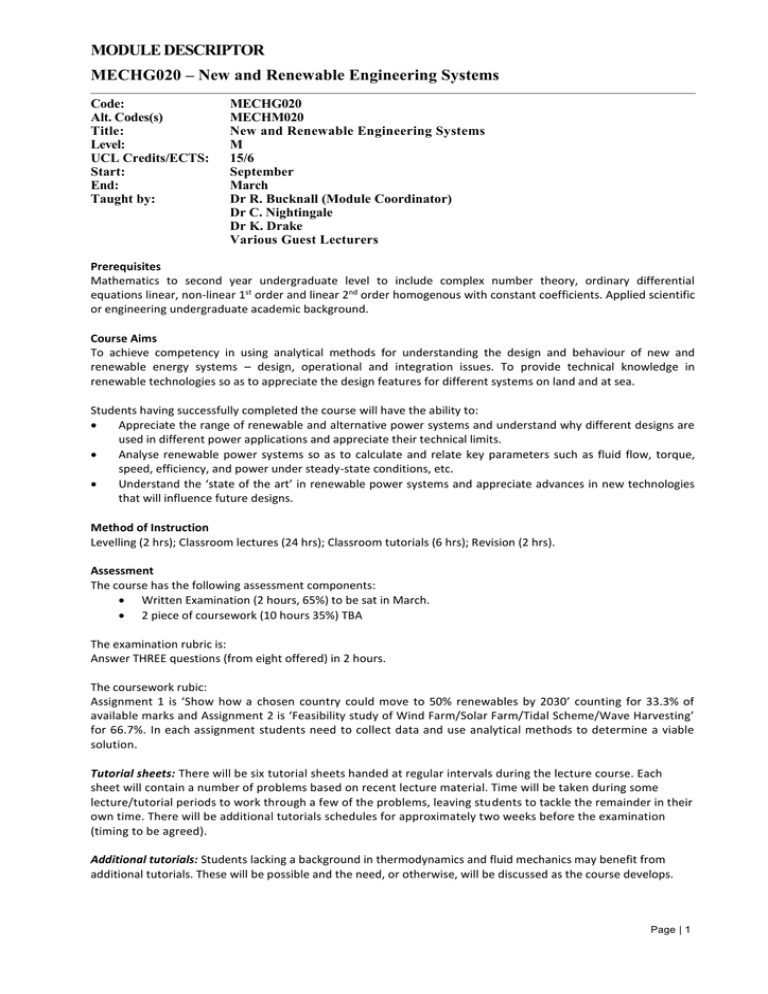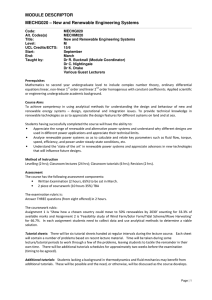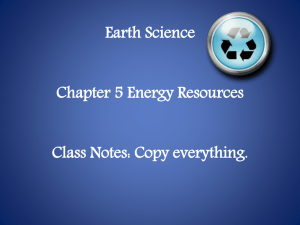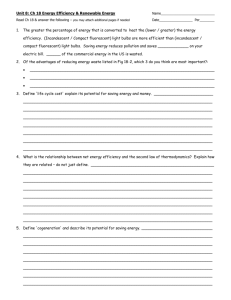MODULE DESCRIPTOR MECHG020 – New and Renewable Engineering Systems
advertisement

MODULE DESCRIPTOR MECHG020 – New and Renewable Engineering Systems Code: Alt. Codes(s) Title: Level: UCL Credits/ECTS: Start: End: Taught by: MECHG020 MECHM020 New and Renewable Engineering Systems M 15/6 September March Dr R. Bucknall (Module Coordinator) Dr C. Nightingale Dr K. Drake Various Guest Lecturers Prerequisites Mathematics to second year undergraduate level to include complex number theory, ordinary differential equations linear, non-linear 1st order and linear 2nd order homogenous with constant coefficients. Applied scientific or engineering undergraduate academic background. Course Aims To achieve competency in using analytical methods for understanding the design and behaviour of new and renewable energy systems – design, operational and integration issues. To provide technical knowledge in renewable technologies so as to appreciate the design features for different systems on land and at sea. Students having successfully completed the course will have the ability to: Appreciate the range of renewable and alternative power systems and understand why different designs are used in different power applications and appreciate their technical limits. Analyse renewable power systems so as to calculate and relate key parameters such as fluid flow, torque, speed, efficiency, and power under steady-state conditions, etc. Understand the ‘state of the art’ in renewable power systems and appreciate advances in new technologies that will influence future designs. Method of Instruction Levelling (2 hrs); Classroom lectures (24 hrs); Classroom tutorials (6 hrs); Revision (2 hrs). Assessment The course has the following assessment components: Written Examination (2 hours, 65%) to be sat in March. 2 piece of coursework (10 hours 35%) TBA The examination rubric is: Answer THREE questions (from eight offered) in 2 hours. The coursework rubic: Assignment 1 is ‘Show how a chosen country could move to 50% renewables by 2030’ counting for 33.3% of available marks and Assignment 2 is ‘Feasibility study of Wind Farm/Solar Farm/Tidal Scheme/Wave Harvesting’ for 66.7%. In each assignment students need to collect data and use analytical methods to determine a viable solution. Tutorial sheets: There will be six tutorial sheets handed at regular intervals during the lecture course. Each sheet will contain a number of problems based on recent lecture material. Time will be taken during some lecture/tutorial periods to work through a few of the problems, leaving students to tackle the remainder in their own time. There will be additional tutorials schedules for approximately two weeks before the examination (timing to be agreed). Additional tutorials: Students lacking a background in thermodynamics and fluid mechanics may benefit from additional tutorials. These will be possible and the need, or otherwise, will be discussed as the course develops. Page | 1 Resources Laboratory fuel cell and various computer based simulation packages. Additional Information None Content Introductory lectures on current main sources of energy: Oil, coal, gas, nuclear. Current contribution of each, known reserves, threats and future predictions. Hubbert model for predicting future usage. Carbon Capture technology and applications should be mentioned somewhere. Solar Energy: Brief revision of radiant heat transfer. Prediction of solar energy falling on an inclined surface (vector derivation and path length equation). Shading. Types of thermal solar collector and typical installations. Solar thermal e.g. Solar Tres Operation of photovoltaic cells, their characteristics and equivalent circuits. Interface with electrical systems both micro-grid and national grid. Wind Energy: Types of wind turbine, including descriptions of typical modern horizontal axis machines. Challenges of offshore installations. Wind speed distribution characteristics. Influences of height and terrain. Site selection. Calculation of Betz limit. Blade design of horizontal axis wind turbines. Lift, drag and power coefficient characteristics. Blade and machine matching. Synchronous and asynchronous generator characteristics and methods of connecting to grid. Sources of wind data. Subsea transmission and interconnection issues for offshore wind energy. Hydro, Tide and Wave Energy: Description of the tidal mechanism. Descriptions of marine current devices. Selection of suitable sites. Dimensional analysis applied to marine current turbines. Hydroelectric and tidal barrage turbines: installation of turbines, blade calculations for Impulse, Francis and Kaplan designs. Tidal barrage scheme strategies. Wave energy devices. Calculation of wave energy. Wave energy maps. Osmotic power. Geothermal Energy: Geology of suitable sites. Description of electrical power generating cycles. Geothermal heating systems. Ground-source heat pumps. Fuel Cells: Historical development of alkaline fuel cell. Modern fuel cell applications. Ideal fuel cell calculations. Variation of Gibbs Function. Fuel cell efficiency. Brief description of main types of fuel cell. More detailed description of Proton Exchange Membrane and Solid Oxide Fuel Cells and their characteristics. Modelling of fuel cell losses. Fuel cells in combined cycle applications. Domestic cogeneration fuel cell systems. Alternative Fuels (mainly hydrogen): Fuelling requirements for fuel cells. Steam and other reforming reactions for hydrogen. Desulphuriation and carbon monoxide removal. Direct oxidation of natural gas in a fuel cell. Hydrogen production by electrolysis. Biological production of hydrogen. Methods of storing hydrogen. Comparison of properties of alternative fuels. Combustion of hydrogen. Production of methanol and ethanol. Combustion of methanol and ethanol. Biodiesel production and environmental impact. Combustion of biodiesel. Other Renewable Energy Sources: Brief discussions of: biomass; ocean thermal energy conversion; topical new schemes. Energy Storage Systems: Comparison of mechanical energy storage systems. Applications where energy storage is required. Flywheel systems and their applications. Calculations of flywheel energy storage. Compressed air storage systems and schemes to mitigate energy loss. Hydraulic energy storage systems and associated calculations. Pumped water storage. Flow batteries. Storage of heat, Supercapacitors, SMES, Battery Technologies (lead acid, LiPol, etc) Integration: Supply and demand characteristics. Base load provision. Grid limitations. Methods of controlling demand. AC/DC transmission. Variation in demand daily, weekly, expected, unexpected events. Page | 2 Learning Outcomes1 MECHG020 Alternative and Renewable Power Engineering General Learning Outcomes Ability to develop, monitor & update a plan, to reflect a changing operating environment N/A Ability to monitor and adjust a personal program of work on an on-going basis, and to learn independently As with all taught modules on the programme a significant amount of self learning is expected. The ability to exercise initiative and personal responsibility, which may be as a team member or leader N/A The ability to learn new theories, concepts and methods etc and apply these in unfamiliar situations The module is designed to present new subject matter at M level understanding of which is then tested by an exam and a small project and a laboratory write up. Specific Learning Outcomes Underpinning science & Mathematics A comprehensive understanding of the relevant scientific principles of the specialisation Although many students will have studied some aspects of alternative and renewable technologies at undergraduate level the module is designed to introduce new subject matter. Specifically students study renewable technologies including wind, wave, current, geothermal, OTEC power generation systems and new technologies such as advanced energy storage systems such as advanced battery technology, flywheel energy storage, alternative fuels such as Hydrogen and fuel cell cells. In each the relevant scientific principles are taught building on fundamental theory. A critical awareness of current problems and/or new insights much of which is at, or informed by, the forefront of the specialisation. The whole subject area is rapidly developing and the module strives to keep up to date with latest developments feeding in output from the department’s research where appropriate. Examples of how this is conveyed to students is through dissemination of research activities in renewable energy e.g. offshore wind farm reliability, availability and maintainability studies and the fuel cell performance studies. Furthermore students are exposed to industrial projects through visits e.g. to a wind farm as part of the course. This dissemination process is through lectures but also through student coursework assignments the students are expected to undertake directed and general reading in support. An understanding of concepts relevant to the discipline, some from outside engineering, and the ability to critically evaluate and apply them effectively. The module is designed to present new subject matter at M level, understanding of which is then tested by an exam and a small project. Lectures, in addition to theory, cover case studies and in these lectures reference is made to influence of outside pressures including differing opinions on the balance of conventional, renewable and nuclear power. Students are encouraged to keep abreast of current affairs with respect to power system developments of all types. 1 EAB website http://www.enoab.oro.uk/documentation document Accreditation Of Masters Degrees Other Than MEng last accessed 10 Aril 2012 Page | 3 Engineering Analysis Ability to use fundamental knowledge to investigate new and emerging technologies The module strives to keep abreast of the state of the art and provide students with the tools to understand these and appreciate advances in technology and control that are influencing future designs. Ability to apply appropriate models for solving problems in engineering and the ability to assess the limitations of particular cases; N/A The ability to collect and analyse research data and use appropriate engineering tools to tackle unfamiliar problems, such as those with uncertain or incomplete data or specifications, by the appropriate innovation, use or adaptation of engineering analytical methods. This aspect is tested in student coursework assignments. Assignment 1 is ‘Show how a chosen country could move to 50% renewables by 2030’ counting for a third of available marks and Assignment 2 is ‘Feasibility study of Wind Farm/Solar Farm/Tidal Scheme/Wave Harvesting’ for two thirds. In each assignment students need to collect data and use analytical methods to determine a viable solution. Design The ability to apply original thought to the development of practical solutions for products, systems, components or processes N/A Economic, Social and Environmental Context Knowledge and understanding of management and business practices, and their limitations, and how these may be applied appropriately, in the context of the particular specialisation N/A The ability to make general evaluations of risks through some understanding of the basis of such risks N/A Engineering Practice A thorough understanding of current practice and its limitations, and some appreciation of likely new developments Students become aware of current practice and limitations of energy systems through the lecture series whilst studying each technology and reinforced through discussion of current and future projects where opportunities and constraints are identified. Furthermore students undertake assignments which are designed to encourage them to examine current practice and new developments through their own research activities. Advanced level knowledge and understanding of a wide range of engineering materials and components N/A The ability to apply engineering techniques taking account of a range of commercial and industrial constraints Students undertake a coursework focusing on the ‘Feasibility study of Wind Farm/Solar Farm/Tidal Scheme/Wave Harvesting’ when they apply their engineering knowledge to a power generation problem and in doing so identify commercial and industrial constraints e.g. cost of generated electricity and any infrastructure limitations. Page | 4







